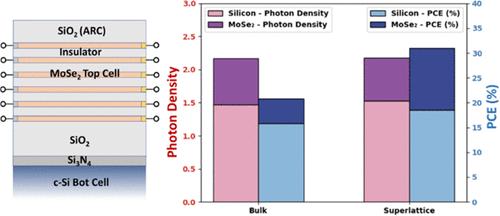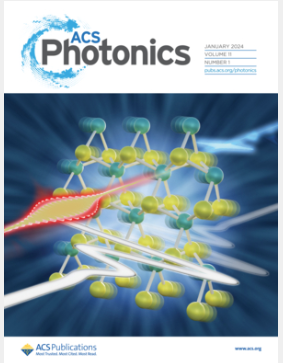硅上二维过渡金属二卤化物的串联光伏技术
IF 6.7
1区 物理与天体物理
Q1 MATERIALS SCIENCE, MULTIDISCIPLINARY
引用次数: 0
摘要
对高效率光伏系统的需求要求创新技术能够超越单结太阳能电池的效率限制。本研究调查了一种串联光伏结构,该结构由带有过渡金属二钙化物(TMDC)超晶格吸收器的顶部电池和晶体硅(c-Si)底部电池组成,重点是优化组合结构的光吸收和电气性能。通过传递矩阵法和电学模拟,我们优化了超晶格的几何形状,确定了带有 40 nm SiO2 抗反射层的六层 MoSe2 配置可最大限度地吸收光子,同时减轻额外重量并保持电池的结构完整性。结果表明,优化的 TMDC 超晶格将串联设计的功率转换效率(PCE)显著提高到 30.94%,比原始单结晶体硅太阳能电池的效率提高了 7.66%。这一进展说明了 TMDC 材料在下一代太阳能电池中的应用潜力,并为开发高效串联光伏系统提供了一条很有前景的途径。本文章由计算机程序翻译,如有差异,请以英文原文为准。

Tandem Photovoltaics from 2D Transition Metal Dichalcogenides on Silicon
The demand for high-efficiency photovoltaic systems necessitates innovations that transcend the efficiency limitations of single-junction solar cells. This study investigates a tandem photovoltaic architecture comprising a top-cell with a transition metal dichalcogenide (TMDC) superlattice absorber and a bottom-cell of crystalline silicon (c-Si), focusing on optimizing the light absorption and electrical performance of the combined structure. Through the transfer matrix method and electrical simulations, we optimized the geometry of the superlattice, determining that a six-layer MoSe2 configuration with a 40 nm SiO2 antireflective layer maximizes photon absorption while mitigating additional weight and preserving the cell’s structural integrity. The results show that the optimized TMDC superlattice significantly improves the power conversion efficiency (PCE) of the tandem design to 30.94%, an increase of 7.66% over the original single-junction c-Si solar cell’s efficiency. This advancement illustrates the potential of TMDC materials in next-generation solar cells and presents a promising avenue for the development of highly efficient, tandem photovoltaic systems vis van der Waals integration of the to-cell on Si.
求助全文
通过发布文献求助,成功后即可免费获取论文全文。
去求助
来源期刊

ACS Photonics
NANOSCIENCE & NANOTECHNOLOGY-MATERIALS SCIENCE, MULTIDISCIPLINARY
CiteScore
11.90
自引率
5.70%
发文量
438
审稿时长
2.3 months
期刊介绍:
Published as soon as accepted and summarized in monthly issues, ACS Photonics will publish Research Articles, Letters, Perspectives, and Reviews, to encompass the full scope of published research in this field.
 求助内容:
求助内容: 应助结果提醒方式:
应助结果提醒方式:


